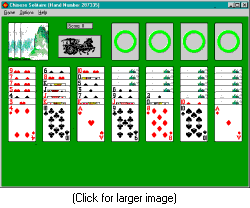 This is an original game combining the best elements of Klondike (one of the world's most popular solitaires) and Scorpion (a game that offers tremendous opportunity for skillful play), with a distinctly Oriental flair. It offers ample opportunity for skill, yet it's very winnable.
This is an original game combining the best elements of Klondike (one of the world's most popular solitaires) and Scorpion (a game that offers tremendous opportunity for skillful play), with a distinctly Oriental flair. It offers ample opportunity for skill, yet it's very winnable.
The game is a variation on "Yukon", and plays like a cross between "Klondike" and "Scorpion", two of the very best and most popular solitaires.
Chinese Solitaire is feature-packed, with full statistics, an optional "easy" mode, autoplay, undo, the ability to save a game in progress (and later restore it), selectable card backs and colors, great graphics, excellent sound, and extensive online help. It is a highly addictive game!
The current version is v1.20, released 01/09/1999.
For even more games similar to this one, check out Absolute Yukon Solitaire.
Download
The following file contains the Chinese Solitaire installation program. Simply click on the link to download it to your computer, then run it to begin installation of the game.
- Download Chinese Solitaire (691K)
License
Chinese Solitaire was originally released as shareware, meaning that you could try it for free, and purchase it if you enjoyed the game. Now, I wish to make the game completely free, with no payment required.
However, I no longer have the development tools necessary to rebuild the application and remove the registration reminder notification. So, when you run the game for the first time, it will tell you that it's shareware, and will ask for a registration code.
Therefore, I am providing the registration code for free. Just enter "" when the program asks.
This free game is provided as-is, with no additional support available. Enjoy!
Rules
For complete rules to the game, as well as suggested strategy, and odds for winning, visit the Chinese Solitaire Rules page.
Requirements
Chinese Solitaire requires Windows 3.1 or later and VBRUN300.DLL. VGA (640x480) graphics is required; SVGA (800x600) is recommended. A sound card is optional but recommended.
Note: This game was designed for Windows 3.1. This program may or may not run under the version of Windows on your computer.
Chinese Solitaire FAQ
- What's "easy mode"?
- Normally, only kings may be moved into empty spaces on the tableau, but if easy mode is enabled, any card can be moved into a tableau space. It certainly doesn't make the game a certain win, but it does increase your chances.
- What is the "Hand Number" displayed on the title bar?
- Chinese Solitaire allows you to choose from a large number of different hands, where each hand is shuffled slightly differently. You can play a particular hand by selecting "Select Hand ..." from the "Game" menu. You might want to do this if you find a particular hand especially challenging, and want to have a friend try to beat it. Just give your friend the hand number, and they can give it a go.
- What's that picture on the button on the main screen supposed to be?
- Uhh, that's supposed to be an oriental horse and chariot, and it's supposed to be the "auto" button, to move cards automatically from the tableau to the appropriate foundation. Left-click it to make a single automatic move, or right-click it to make all possible moves in a single click.
- How can I add my own sounds in place of the default sounds?
- First off, you'll need sounds in WAV format (the standard Windows sound effects format), which you can acquire from many sources, including CD-ROMs, the Internet (The Daily WAV is a good place to start), or you can record them yourself with a microphone. Once you have the WAV files you want to use, copy them into the directory with the rest of the Chinese Solitaire files (by default, this is C:\CHINASOL). Then, select "Sound ..." from the "Options" menu, and click on the drop-down list boxes on the right side of the dialog, and select the filename corresponding to the sound you want to play.
- How can I change the background music?
- The background music is in MIDI format (file extension = ".MID"). You can find MIDI files on the web (Standard MIDI Files on the Net) or on the newsgroup alt.binaries.sounds.midi. Copy the file(s) into the Chinese Solitaire directory, select "Sound ..." from the "Options" menu, and click on the drop-down list box next to "Background Music" and pick a new file.
- What language was Chinese Solitaire written in?
- It was originally written for Microsoft Visual Basic Professional, version 2.0; it currently uses VB3. David Baldwin's RTFGEN was used to create the help file. A customized version of Stephen Murphy's QCARD.DLL is used for the card graphics.
